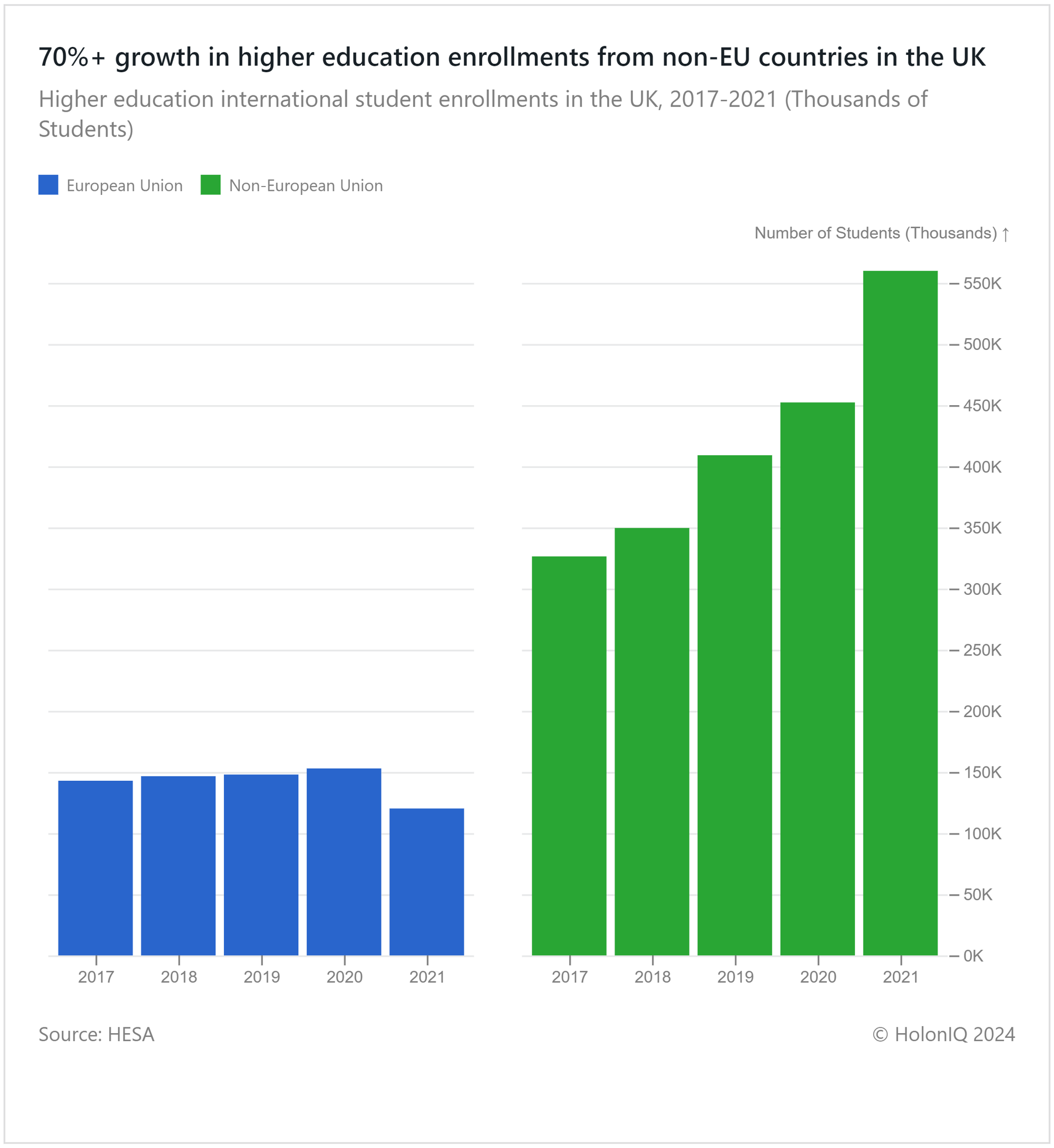⛽ Ships Over Pipes for LNG. Critical Minerals. International Students.
Chart of the Day #87 looks at The UK’s International Student Growth, Global Battery Mineral Production, and LNG Trade.
Namaste 🙏
The US Treasury has delayed restrictions on hard-to-trace battery materials, notably for graphite from China. A Japanese consortium has unveiled the world's first high-speed 6G prototype device, a 20x improvement over current 5G technology. Starting in September 2024, Canada has extended the temporary 20-hour weekly working cap for international students to 24 hours off-campus per week.
Today's Topics
🌍 International Students. 70%+ growth in UK’s Non-EU international student enrollments
🔋Battery Minerals. Global production of copper and magnesium exceeded 20K tons in 2022
⛽ LNG Trade. 56% of LNG trade relies on ships
For unlimited access to over one million charts, request a demo.
🌍 70%+ Growth in UK’s Non-EU International Student Enrollments

The number of international student enrollments in UK universities increased by 12% in 2021 compared to 2020. However, the trend diverged between EU and non-EU students. While non-EU student enrollment grew to over 550K, particularly at the postgraduate level (+37%), EU enrollment dropped by 16%, likely due to the changes in 2021/22 that eliminated subsidized student financing and introduced full fees for EU students. Among EU countries, Greece (-26%), Poland (-26%), and Romania (-31%) saw the steepest declines. Conversely, non-EU countries like Nigeria, Pakistan, and Bangladesh experienced strong growth, exceeding 90% in some cases for new enrollments.
Despite the influx of international students, competition for university places remains fierce. This challenge is compounded by the high cost of living in the UK and recent policies restricting overseas students from bringing their families and removing the possibility of switching to a work visa before completing their studies. Yet, the UK has retained its popularity as a top study destination, with internationally recognized degrees providing students with valuable assets for their future careers.
🔋 Global Production of Copper and Magnesium Exceeded 20K Tons in 2022
In 2022, global production of magnesium and copper exceeded 20,000 tons, with magnesium totaling 27 kilotons and copper reaching 22 kilotons. These minerals are essential across various sectors, particularly clean energy technologies. Magnesium, valued for its ability to enhance battery strength and lightness, and copper, crucial for electrical conductivity, play pivotal roles in battery production. In August 2023, the US Department of Energy recognized copper as a critical raw material, aligning with other nations such as the EU, Japan, India, China, and Canada in acknowledging its importance for energy transition technologies.
The increase in electric vehicle (EV) sales is fueling an increase in battery demand, further driving the ongoing trend for battery mineral consumption. This heightened demand is increasing exploration efforts, as evidenced by India's pursuit of two additional deep-sea exploration licenses in the Indian Ocean to extract these essential battery minerals.
⛽ 56% of LNG Trade Relies on Ships
Historically, natural gas trade predominantly relied on pipelines; however, recently transporting it via ships has gained popularity. By 2020, ship transportation surpassed pipelines, with over 56% (540 billion cubic meters) of liquefied natural gas (LNG) being transported by ships in 2022. LNG is made by cooling fracked natural gas to −162°C, reducing it to 1/600th of its original volume, facilitating safe and efficient transportation via non-pressurized storage, making it most suitable for international shipping. Studies indicate that LNG becomes more cost-effective as transport distance increases. Generally, shipping LNG becomes cheaper than off-shore pipelines for distances beyond 700 miles (~1127km), while the threshold is 2,200 miles (~3,541km) for on-shore pipelines.
The shift from pipelines to ships is likely driven by the expansion of LNG exports from the US and Qatar, which primarily export across seas, despite European countries being well-connected by land and possessing a vast network of pipelines like the Nord Stream, Blue Stream and TurkStream. Europe, a significant LNG importer, plans to expand its LNG terminals and gas pipelines, increasing the region's total gas import capacity by 55% at an investment of €84.1B ($90.57B), widening existing overcapacity.
Like getting this newsletter? For unlimited access to over one million charts, request a demo.
Thank you for reading. Have a great week ahead!
Have some feedback or want to sponsor this newsletter? Let us know at hello@holoniq.com
